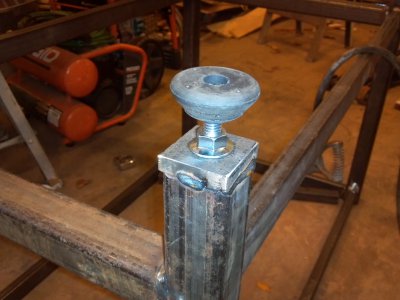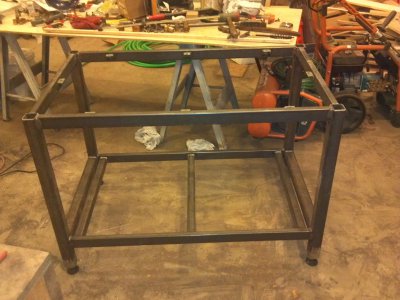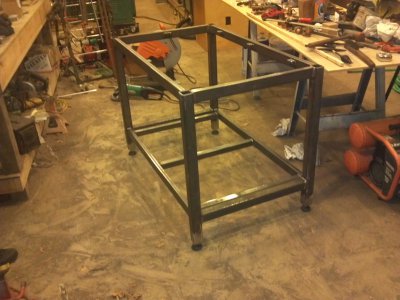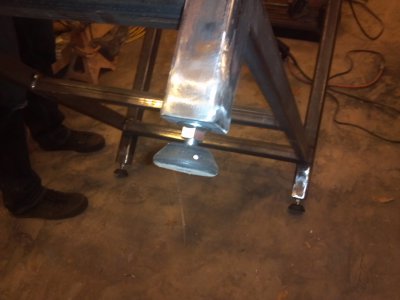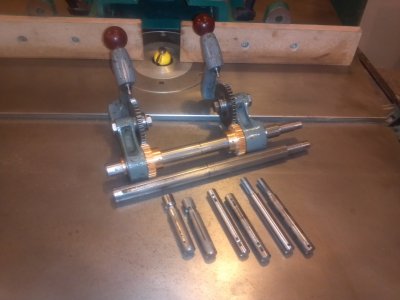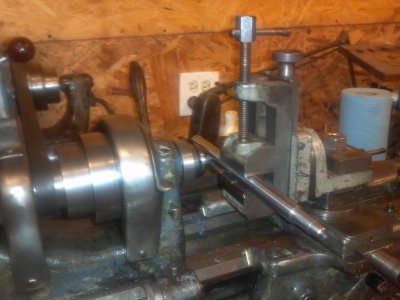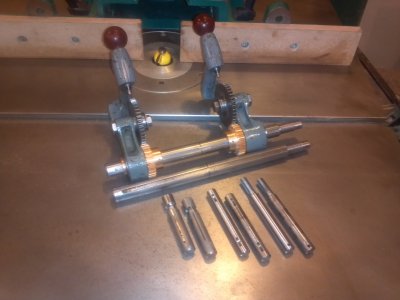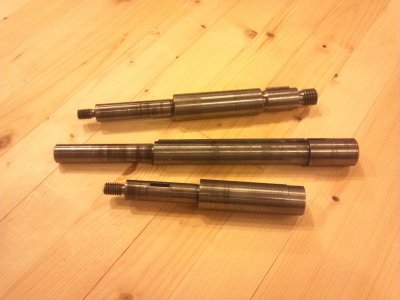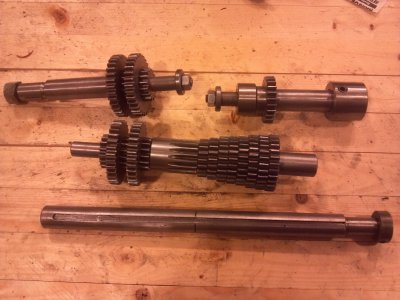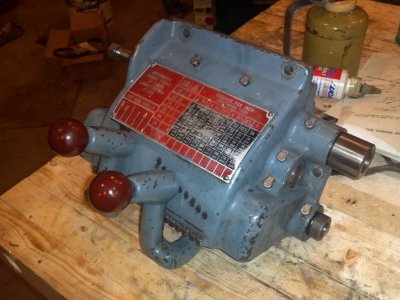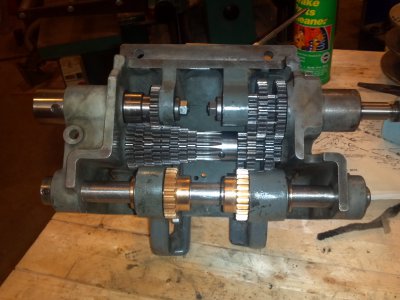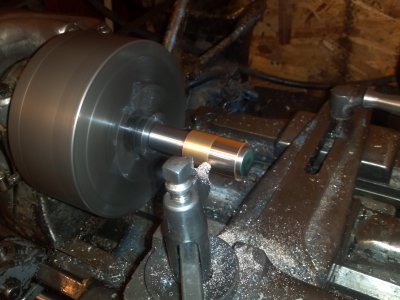- Joined
- Oct 7, 2013
- Messages
- 305
Worked a little more on the workbench yesterday. Got a couple cross braces welded on and got the pads made for the adjustable feet. Got one foot pad tacked onto a leg. To make the foot pads, I cut 2X2X1/2" pieces from a piece of 1/2" X 2" bar stock, ground them to clean up the edges, then chucked them in my 4-jaw to drill and start the 1/2 - 13 tap. Then I welded a 1/2 - 13 nut to one side to give additional thread and strength to hold the foot, then tacked it to the end of the leg. I'll finish the welds on all four sides, then grind them smooth, just for looks. I will weld 6 tabs to the top members, which will be used to attach a top made of 1-1/2X2 lumber bolted together and finished with boiled linseed oil. That will probably get a sheet of 10 ga steel on top of it, to make it more durable and easier to clean. The workbench will get Rustoleum primer and Rustoleum black paint. Later, I'll build a machinist tool chest full of drawers to fit under the worktop.
Fun.
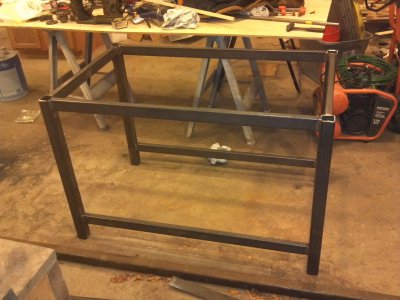
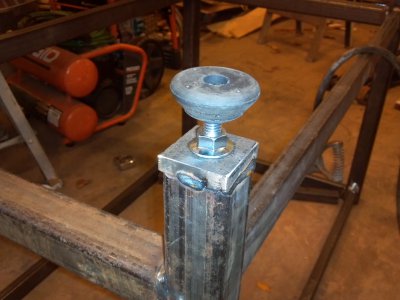
I also took some pictures of the taper attachment, while I was answering some questions on another thread. Thought I'd go ahead and post them here. I have what is called in the South Bend catalogs as a "Plain Taper Attachment", which means you have to remove a screw in the cross slide that retains the cross feed nut in order to use the taper attachment. When the taper attachment is used, a bed clamp (which my unit is still lacking) is clamped to the bed and the screw mentioned is removed, and the handle you see on the taper attachment is locked down, thus allowing the cross slide to move with the taper attachment as it slides along its length, which is set at the desired angle. When the taper attachment is not in use, the bed clamp is loosened, as is the handle on top, and the screw is replaced to secure the feed nut. The whole taper attachment then moves parallel to the bed with the carriage, longitudinally, and the cross slide is again operated by the handwheel. Because of that, many people remove the bed clamp to avoid needless wear from it sliding along the bedway. Somewhere along the way in the life of my lathe, the bed clamp got separated from the lathe and was lost. Apparently this isn't an uncommon problem, as I have seen a number of taper attachments that are missing the bed clamp bracket. I have located a bed clamp, but must wait a bit to buy it (Christmas must get paid for first, you know).
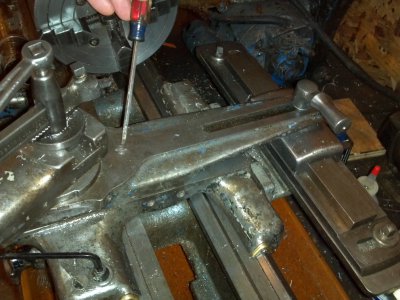
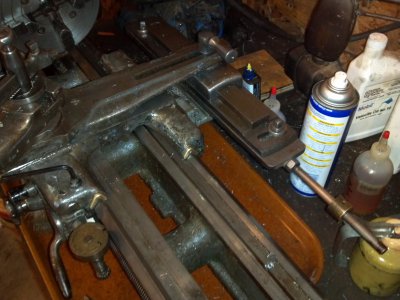
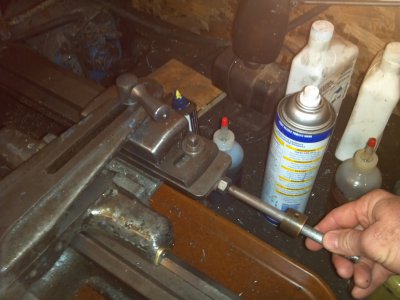
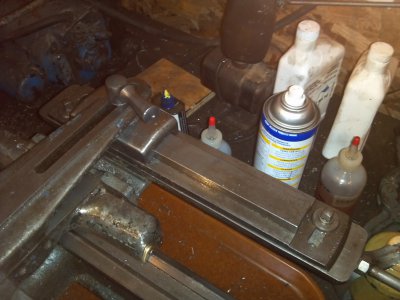
Lathe is a little dirty, since I had just finished drilling and tapping the workbench feet. Can't wait to be able to take the lathe down and clean and paint everything. Got to get my DR operational first.






Fun.


I also took some pictures of the taper attachment, while I was answering some questions on another thread. Thought I'd go ahead and post them here. I have what is called in the South Bend catalogs as a "Plain Taper Attachment", which means you have to remove a screw in the cross slide that retains the cross feed nut in order to use the taper attachment. When the taper attachment is used, a bed clamp (which my unit is still lacking) is clamped to the bed and the screw mentioned is removed, and the handle you see on the taper attachment is locked down, thus allowing the cross slide to move with the taper attachment as it slides along its length, which is set at the desired angle. When the taper attachment is not in use, the bed clamp is loosened, as is the handle on top, and the screw is replaced to secure the feed nut. The whole taper attachment then moves parallel to the bed with the carriage, longitudinally, and the cross slide is again operated by the handwheel. Because of that, many people remove the bed clamp to avoid needless wear from it sliding along the bedway. Somewhere along the way in the life of my lathe, the bed clamp got separated from the lathe and was lost. Apparently this isn't an uncommon problem, as I have seen a number of taper attachments that are missing the bed clamp bracket. I have located a bed clamp, but must wait a bit to buy it (Christmas must get paid for first, you know).




Lathe is a little dirty, since I had just finished drilling and tapping the workbench feet. Can't wait to be able to take the lathe down and clean and paint everything. Got to get my DR operational first.








